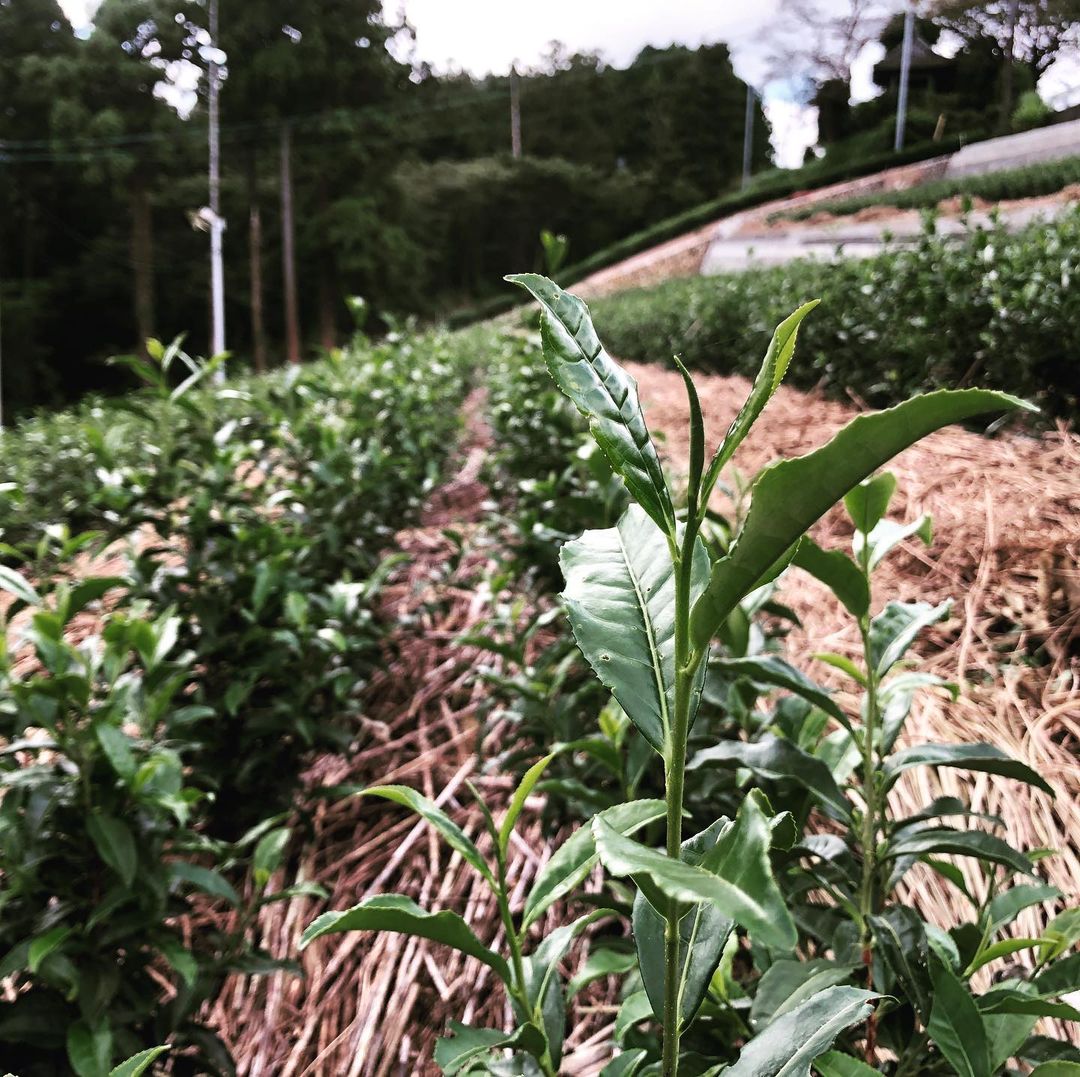茶から海へ:森林、栄養動態、そして茶栽培
ジミー・バーリッジ著
注目画像: 松本兼六茶園の茶草場栽培。茶畑の周囲の草を刈り、乾燥させ、株間に敷き詰めることで、茶畑の肥沃化と雑草の抑制を図っています。写真は、植えたばかりの幸春品種の茶畑です。
水蒸気は上昇し、山へと漂います。雨は山に降り注ぎ、土壌に染み込み、泉となって海へと流れ込みます。私たちの農業は土壌、水、そして水の流れにまで影響を与えます。山の茶も海の魚も、私たちに共に良い関係を築くよう呼びかけています。その結果、良質な茶と健全な生態系が生まれるのです。
導入
人間、森林、そして水の関係は、私たちが世界に影響を与える最も古く、長きにわたり、そして根本的な方法の一つです。本稿では、人々とその農業ニーズが、山から海に至るまで、土地や水路とどのように関わってきたかを概観し、特に茶葉に焦点を当てます。茶園における栄養動態に触れ、茶葉生産が下流の環境にどのような影響を与えるかを説明します。上流域の人々と下流域の人々の間の協力が、両者が依存する生態系の適切な機能をどのように確保しているかを示す事例を紹介します。
歴史的な森林管理
日本の農業の歴史は、地質、地形、そして統治者や人口集中地の支配によって特徴づけられています。最も顕著な例として、記念碑建造、都市建設、木炭製造、そして農民の燃料、建築資材、肥料、そしてもちろん食料生産のための緑化資材の需要によって、次々と樹木伐採が進められました。学者のコンラッド・トットマン氏は、日本の森林利用と管理の歴史について優れた研究を行っています。こちらに短い論文へのリンクがあります。森林史に関するセクションの資料の大部分は彼の研究に基づいています。参考文献をご覧ください。
日本で最も古く、壮大な樹木が最も有名で、おそらくは広範囲に利用されたのは、数多くの寺院、神社、城、そして大名や天皇の邸宅の建設でした。帝国が拡大するにつれ、ほぼ完全に木材で建設された都市も増加しました。家庭の調理中の火事や戦争による火災は、建物を頻繁に破壊し、時には都市の大部分を破壊したため、再建のためにさらに多くの木材が伐採されました。
 東京・御岳山にある大きな古木。写真提供:岸田萌絵
東京・御岳山にある大きな古木。写真提供:岸田萌絵
森林管理は、現代の栄養管理の先駆けとも言えるもので、主に二つの目的で行われました。一つは林産物の安定供給を確保すること、もう一つは浸食、堆積、森林からの不均一な水供給によって引き起こされる洪水や干ばつなど、下流への悪影響を防ぐことです。水が堆積物を運ぶことで生じる堆積は、魚類や水生生物にとっての水質を即座に低下させるという悪影響を及ぼし、さらにこの堆積物が下流に堆積すると、水の流れや川の健全性にも悪影響を及ぼします。この堆積によって川は浅くなり、川幅も広くなるため、流れが遅くなり、さらなる堆積が促進されます。これは一種のフィードバックサイクルです。堆積は水田などの低地の畑を洪水の影響を受けやすくします。そのため、統治者は上流への堆積物の流出を減らすことで、これらの生産性の高い畑への被害を防ごうとしました。これに加えて、建設、石炭、その他さまざまな用途のために木を伐採し続けたいという願望により、日本では森林管理が推進され、保全、計画伐採、再生の考慮、再植林、そして人工林業といった実験が進められました。
 主に1種類の樹木からなる、若い再植林地の写真2枚。左は愛知県、右は東京都青梅市。写真提供:岸田萌絵。
主に1種類の樹木からなる、若い再植林地の写真2枚。左は愛知県、右は東京都青梅市。写真提供:岸田萌絵。
森林資源をより集約的かつ分散的に利用したのは農民であり、彼らは歴史の大部分において当然ながら人口の大多数を占めていました。農村の人々は調理や暖房用の燃料を集めるだけでなく、木炭を作るための木材も収集し、都市住民に販売していました。さらに、日本の伝統的な農業システムは、ブラシ、草、苔、落ち葉など、基本的に堆肥化可能なあらゆる有機物を収集し、農地の土壌に混ぜ込むことに依存しています。この有機物は分解され、栄養素がゆっくりと作物に利用できるようになります。伝統的な農法を美化しないためにも、多くの農民が有機物を燃やし、灰を土壌に混ぜていたことも言及しておかなければなりません。これにより栄養素ははるかに早く利用可能になりましたが、明らかにほぼすべての炭素が失われ、大気中の二酸化炭素濃度の上昇につながりました。
燃料や建築目的の大規模かつ集中的な樹木伐採は、都市、寺院、貴族の邸宅、そして農民による下草、苔、森林の残骸の採取に顕著に見られ、日本の森林構造、構成、そして生態系を決定づけ、変容させました。こうした森林構造の変化の影響を示す興味深い例の一つは、多様性に富み成熟した、完全に日陰のある森林を好むヒラタケ(ヒラタケ)が、13世紀頃にマツタケに取って代わられたことです。マツタケは撹乱された景観でも繁殖し、未植林の多様な森林に取って代わられた、マツが優占する森林植林地でもよく育ちます(Totman, 2000)。農業拡大、貴族階級の急速な成長、そしてマツタケの増殖というこの関連性は、マツタケが日本文化の構成要素となった理由を説明する一助となるかもしれません(人間とキノコの関係に興味がある方は、アン・ツィング著『世界の果てのキノコ、マツタケ』をご覧ください)。
 混交林に咲く、繊細で儚いカタクリ(Erythronium japonicum、ヤマユリの一種)。写真提供:岸田萌。
混交林に咲く、繊細で儚いカタクリ(Erythronium japonicum、ヤマユリの一種)。写真提供:岸田萌。
茶は、気温の変化や朝霧といったテロワール(土壌)に付随する環境要因を活用するため、山の斜面で栽培されることが多いですが、米、大豆、ソバ、果物といった他の作物が、管理がはるかに容易な平坦な低地で栽培されているという実利的な理由もあります。茶は、個々の畝が小さな段々畑を占有できるため、急斜面でも栽培しやすいという利点があります。さらに、茶は多年生作物であり、耕起を必要とせず、年間を通じて土壌を覆っているため、耕起を必要とし、年間の一部の期間土壌を覆わない一年生作物ほど土壌浸食を助長しません。
 京都府和束町にある急斜面の茶畑と単一樹林。写真はジミー・バーリッジ撮影。
京都府和束町にある急斜面の茶畑と単一樹林。写真はジミー・バーリッジ撮影。
茶の生産と施肥
近代になって合成窒素肥料が利用可能になる以前、茶農家は日本の他のほとんどの農家と同様に、前述のように森林を含む周辺地域から有機物を採取し、畑に施用していました。茶の場合、これはこのインタビューで言及されている「茶草場法」と呼ばれています。茶草場法、そしてより現代では加工されたコウモリの糞や魚粉を肥料として使用する方法は、自然に存在する土壌微生物も利用する栄養素を比較的ゆっくりと放出します。しかし、特に合成窒素肥料の導入以降、茶には大量の肥料が用いられることが多くなりました。施肥は、春の豊かな生育を促進し、複数回の収穫を可能にします。また、窒素が豊富でうま味に富んだ葉を育てるのにも役立ちます。
以前の投稿で述べたように、高品質のお茶のうま味は、窒素を豊富に含むアミノ酸の量と関連しています。 遮光は、植物がクロロフィル(葉緑素)の生成を促進するための古典的な方法です。クロロフィルは、太陽光を利用して二酸化炭素を糖に変換し、さらにうま味成分である窒素を豊富に含む化合物を生成するユニークな分子です。
合成窒素肥料は、大気中の窒素(互いに三重結合した2つの窒素原子)を分解し、次に窒素を水素と結合させてアンモニアを生成し、その後、植物が利用できる他の形態の窒素を生成することによって生成されます。このプロセスでは、反応に必要な高圧高温環境を作り出すために、大量の化石燃料由来のエネルギーが必要です。このプロセスは第一次世界大戦中に初めて開発されましたが、肥料の大規模生産に使用されたのは第二次世界大戦後です。日本では、多くの地域と同様に、この新しい窒素肥料源は、急速な人口増加と、森林や伝統的な栄養源の深刻な枯渇の時期に登場しました。そのため、伝統的な方法では急速に増加する人口の農業需要を満たすことができないと考える人が多く、実際、世界規模で合成肥料の普及により、何百万人もの人々に食料を供給することができました。日本では、戦後から1990年代にかけて、合成肥料の使用が奨励され、広く使用されました。
合成肥料のトレードオフ
しかし、この施肥は栄養塩の動態、土壌の健康、生態系の機能、さらには人間の健康にまで、時には悪影響を及ぼします。施肥が環境に影響を及ぼす主な方法は、流出、浸出、揮発です。浸出による肥料の流出と地下水汚染は、肥料が土壌に施用されたものの、植物に吸収されなかったり、水によって根圏から運び出される前に土壌に結合しなかったりした場合に発生します。研究によると、施肥量が多い場合、畑に施用された肥料の大半は植物に吸収されず、かなりの量が初年度に環境に失われます (Chen and Lin, 2016)。農地からの栄養素、主にリンと硝酸塩型の窒素 (N) の流出は、藻類ブルーム、ひいては富栄養化の一因となり、水中の酸素レベルが低下して魚類やその他の水生生物が実際に死滅します。同様に、土壌から地下水への栄養分の浸出によって、小川や泉の栄養分の濃度が上昇し、河岸生態系に悪影響を及ぼす可能性があります (Nagumo et al. 、2012)。
米国の読者の皆様はご存知かと思いますが、チェサピーク湾流域は湾の健全性を守るため、集中的な肥料管理が行われています。過去には、意図しない肥料の湾内への流出が大規模な藻類ブルームを引き起こし、富栄養化を招きました。その結果、動植物、そして重要な漁業にも悪影響が及んでいました。バルト海、北東大西洋、黒海など、ヨーロッパの多くの水域も、農業地帯からの過剰な栄養塩流入により深刻な富栄養化問題を抱えています(欧州環境機関報告書概要)。中国でも、過剰な栄養塩が水質と生態系機能を損なっているという深刻な問題を抱えています。
肥料の揮発とは、固体肥料が気体へと変化するプロセスであり、通常は土壌微生物の活動や土壌温度、水分、pHなどの相互作用によって発生します。窒素含有肥料の揮発は、アンモニア(NH3)または亜酸化窒素(N2O)の形で起こります。アンモニアの排出は、第一に土壌に施用した高価な窒素が文字通り漂流してしまうため、農家にとって問題となります。第二に、アンモニアが土壌に戻ると、土壌の酸性化や富栄養化の問題を引き起こす可能性があるためです。農業、特に窒素肥料の使用は、強力な温室効果ガスである亜酸化窒素の重要な排出源となっています(Tian et al. , 2020)。茶畑は日本の農地面積の約1%に過ぎませんが、茶畑は農地からのN2O排出量の10%以上を占めており、茶畑におけるN2O排出量への対策は非常に重要です(Hirono et al. , 2021)。日本では、茶畑からの亜酸化窒素排出量に関する研究が行われており、N2O排出量の理解と削減に役立つツールが提供されています(Hirono and Nonaka, 2012; Zou et al. , 2014)。
土壌は、施肥や茶の栽培によっても酸性化する可能性があります(Yan et al. , 2018)。酸性土壌は、土壌微生物群集だけでなく、根や植物の成長にも影響を与えます。研究では、酸性化した農地から浸出する水がどのように地下水に入り、泉や小川に現れて最終的に魚類や両生類に影響を与えるかが定量化されています(Hirono et al. , 2009; Yan et al. , 2018)。最近の研究では、窒素施肥が土壌微生物群集に与える影響の範囲が広がり、おそらく部分的に酸性化を介して、窒素施肥は微生物の多様性を減少させ、微生物群集の多様性を弱め、土壌微生物群集の安定性を低下させることが明らかになっています(Ma et al. , 2021)。
より優れた管理、適用方法、製品によりトレードオフが減少
窒素施肥量は1960年代から1990年代にかけて増加し、その焦点は窒素施肥量の削減と窒素利用効率の向上に移りました(Hirono et al. , 2021)。静岡県の集約的な茶栽培地域における河川、湧水、地下水の水質に関する広範かつ長期的な環境調査によると、1990年代以降、茶園周辺の水系における硝酸性窒素は低下傾向にあります(Hirono et al. , 2009)。研究者、農学者、農家による多くの研究は、新しい技術やテクノロジーの使用、または単に施肥量、時期、施肥方法を調整することによって、窒素の吸収と利用効率を向上させることに費やされてきました(Watanabe, 1995; Wang et al. , 2020)。傾斜地からの流出を制限することを含む肥料管理戦略が開発されました(Wang et al. , 2018, 2020)。施肥推奨戦略のさらなる発展には、茶葉による栄養素吸収の時間的ダイナミクスをより詳細に解析し、施肥量と吸収量を一致させることが求められています(Tang et al. , 2020)。他の研究では、合成肥料と菜種(アブラナ科植物)由来の肥料を同一量施用した場合を比較し、菜種由来の肥料は土壌酸性化と水質富栄養化のリスクを低減することが示されています(Xie et al. , 2021)。しかしながら、茶園への総肥料施用量(窒素およびリン)は依然として高く、表層水、地下水、さらには湾やラグーン、さらには海自体へのリスクは依然として残っています(Nagumo et al. , 2012)。
 京都府和束町にある喜六茶園では、急勾配の茶畑を的確かつ責任ある方法で管理しています。写真提供: 喜六茶園
京都府和束町にある喜六茶園では、急勾配の茶畑を的確かつ責任ある方法で管理しています。写真提供: 喜六茶園
茶、土壌、水路、そして海をつなぐ
日本の漁師たちは、漁業の健全性と農地や森林の健全性との関連性を数十年、いやおそらくは数世紀も前から認識してきました。海岸林の中には「魚つき林」(魚の養殖林)と呼ばれるものさえあります(岩崎、2021)。森の祠に海水を送ることで、森と海を結びつける季節の行事が今も行われています(岩崎、2021)。また、春の雪解け水によって奈良二月堂の泉が溢れ、海へと流れ込み始めると、春の到来を告げると言われています(ベディーニ、1994)。歴史的に人々が山と海のつながりを認識していたことを示す兆候はあったものの、栄養塩の動態や生態系の機能の劇的な変化が化学肥料の導入と結びつくまでには、ある程度の時間を要しました。
九州県の有明海は、7つの主要河川から淡水が流入する塩水湾である。日本最大の干潟を有し、栄養塩管理と様々な関係者の利害関係の両立という課題を抱えている。有明湾は、野生魚の生育環境を提供しているほか、海藻や貝類を含む養殖業が盛んに行われている(Yagi et al. , 2011)。しかし、その流域は歴史的に集約的な農業の場となっており、現在でも高地では多くの茶が、低地では野菜や米が栽培されている(Shiratani et al. , 2005)。そのため、有明湾への栄養塩流出や土壌浸食は、魚介類や海藻の栽培に影響を及ぼす課題となっている。革新的な水循環システム、高地および低地の農場管理の改善、その他の対策により状況は改善されているが、政府機関、農家、研究者は、課題を理解し解決するための取り組みを続けている。
 東京都青梅市の半管理林を流れる小さな水路を2つの角度から撮影。写真提供:岸田萌絵。
東京都青梅市の半管理林を流れる小さな水路を2つの角度から撮影。写真提供:岸田萌絵。
前述のように、静岡地方では茶畑への施肥量の削減により水質が改善されており(Hirono et al. , 2009)、この傾向は日本の他の茶産地でも一貫していると考えられます。より正確で適切、かつ適切なタイミングでの施肥へと向かう動きが広がっています。伝統的な農法への関心が再び高まっていることは、里山運動が示すように、健全な生態系の再生につながる可能性が高まっています。里山とは伝統的な農業景観であり、農民や林業家が景観を改変し、過去数千年と調和した一種のモザイク状の生態系を作り出しています(伊藤・杉浦, 2021)。里山グループの中には、有名なマツタケを生産する、人間が管理する複雑な景観の創造に注力しているグループもあります(Satsuka, 2014)。若者から高齢者、都市部と農村部が協力して伝統的な農法の活性化に取り組むことは、人々と環境がいかにして共存していくかを再学習できるかを示す、心強い例です。
最近の刺激的な記事では、水質と魚類の生息地の改善を支援する森林と漁業の取り組み事例が3784件特定されています(岩崎、2021年)。著者はいくつかの事例を概説しており、その中には、流域レベルの生態系の健全性を懸念するカキ養殖業者が開始した、宮城県と岩手県における「海は森を欲している」として知られる森林再生プロジェクトも含まれています。熊本県の別の事例は、有明湾におけるアサリ養殖業者に関するものです。そこでの養殖業者は、上流の土壌浸食がアサリに悪影響を及ぼしていることに気づき、高地のコミュニティと協力して、敏感な土地を森林化し、浸食を軽減する取り組みを始めました。他のプロジェクトでは、海藻やウニの生産に関連する問題に取り組みました。日本は、森と海を結びつけることで流域の健全性に取り組む、このような農家主導の取り組みを行っている数少ない国の一つです。これらの共同プロジェクトが示す主体性と協力の種類は、非常に心強いものです。
 京都府和束町で、かわいい森の精霊と幸運のための空間を作る人々!写真はジミー・バーリッジ撮影。
京都府和束町で、かわいい森の精霊と幸運のための空間を作る人々!写真はジミー・バーリッジ撮影。
結論
森林の種構成、森林の樹齢構造、そして土壌自体の変化が、保水能力、そして魚類や両生類の健康と繁殖成功にどのような影響を与えるかについて、私たちはより深く理解しています。産卵のために遡上する回遊魚は、海や下流の湖から栄養分を運ぶ重要な役割を果たしますが、その回遊と繁殖は水路の健康状態に大きく左右されます。
現代の茶生産には、地元産の緑肥、醤油や味噌の製造で使用された大豆、魚粉、コウモリの糞など、有機物由来であっても窒素の投入が必要です。窒素は高価になる場合があり、特に合成窒素は流出したり地下水に浸出したりする可能性があります。適切な製品の選択、施肥時期と施用量を含む適切な管理が重要です。多くの環境に配慮した茶農家は、施肥量の削減と管理の改善の両方を実現しています。茶農家は茶栽培と下流のパートナーとのつながりを認識し、健全な水路の維持に努めています。これは、魚や漁師を含む下流のすべての人々にプラスの影響を与えています。
参考文献
- ベディニ、シルヴィオ. 1994. 『時間の軌跡:東アジアにおける香による時間測定』ケンブリッジ大学出版局.
- Chen CF, Lin JY . 2016. 茶園における施用窒素・リンの総収支の推定. 持続可能環境研究26 , 124–130.
- 広野雄三、野中健二. 2012. 日本の緑茶園からの亜酸化窒素排出量:茶樹の畝間土壌と樹冠下土壌からの排出の寄与. 土壌科学と植物栄養誌58 , 384–392.
- 広野雄三、佐野毅、江口誠. 2021. 1965年から2016年にかけての日本における緑茶消費の窒素フットプリントの変化. 環境科学と汚染研究28 , 44936–44948.
- 広野雄三、渡辺郁、野中健二. 2009. 静岡県の集約的茶栽培地域における水質の傾向. 土壌科学と植物栄養55 , 783–792.
- 伊藤 剛、杉浦 正之. 2021. 生物多様性の生態学的モザイクとしての里山ランドスケープ:地域知、環境教育、そして日本の農村地域の未来. 環境:持続可能な開発のための科学と政策63、14-25 。
- 岩崎 誠. 2021. 日本における漁民主導の森林整備活動:そこから得られた教訓. 地域海洋科学研究45 , 101839.
- Ma L, Yang X, Shi Y, Yi X, Ji L, Cheng Y, Ni K, Ruan J . 2021. 11年間の圃場実験における長期窒素施肥に対する茶の収量、品質、土壌細菌特性の反応。応用土壌生態学166 , 103976。
- 南雲 剛志、与曽井 剛志、有富 章. 2012. 森林主体の茶栽培流域における農地利用が窒素・リン濃度に与える影響. 土壌科学と植物栄養学58 , 121–134.
- 佐塚S. 2014.「里山運動:脱工業化社会における多種多様なコモンズを構想する」RCCパースペクティブ、87-93。
- 白谷英之、久保田 剛、吉永 郁、瞳 孝文. 2005. 有明湾沿岸水域における農業による窒素流動への影響. 生態学と土木工学8 , 73–81.
- Tang S, Liu Y, Zheng N, et al. 2020. QUEFTS解析に基づく中国における茶(Camellia sinensis)の栄養要求量の時間的変動. Scientific Reports 10 , 1–10.
- Tian H, Xu R, Canadell JG, et al. 2020. 世界の亜酸化窒素の発生源と吸収源の包括的な定量化. Nature 586 , 248–256.
- トットマン、コンラッド. 1998. 『緑の群島:産業革命以前の日本の林業』オハイオ大学出版局.
- トットマン、コンラッド. 2000. 『日本の歴史』ブラックウェル出版.
- Wang Z, Geng Y, Liang T. 2020. 茶園における化学肥料使用量削減の最適化:環境および経済効果の評価に基づく。『総合環境科学』 713 , 136439。
- Wang W, Xie Y, Bi M, Wang X, Lu Y, Fan Z. 2018. SWATモデルを用いた、異なる斜面勾配を持つ茶園における窒素負荷軽減に対する最善の管理方法の影響. 応用地理学90 , 200–213.
- 渡辺一郎. 1995. 緑茶の異なる栽培段階での窒素肥料施用が品質に及ぼす影響. 土壌科学と植物栄養41 , 763–768.
- Xie S, Yang F, Feng H, Yu Z, Liu C, Wei C, Liang T. 2021. 有機肥料は茶園における流出水中の炭素と窒素を削減し、土壌の酸性化を緩和する:栄養含有量と同位体分別の証拠. Science of the Total Environment 762 , 143059.
- 八木雄二・木下郁・藤田聡・青山大・河村雄二. 2011. 有明湾における魚類の生育場としての河口上流域の重要性. 魚類環境生物学91 , 337–352.
- Yan P, Shen C, Fan L, Li X, Zhang L, Zhang L, Han W . 2018.「茶の栽培は土壌の酸性化と土壌中の窒素・リンの分布に影響を与える」農業・生態系・環境誌254 , 20–25.
- 鄒 勇・広野 勇・柳井 勇・服部 誠・豊田 聡・吉田 暢. 2014. 静岡県中部のチャノキ栽培土壌に蓄積された亜酸化窒素のアイソトポマー分析. 土壌生物化学77 , 276–291.



1件のコメント
This subject is of deep interest to me.
Thanks for writing this, very well thought out.